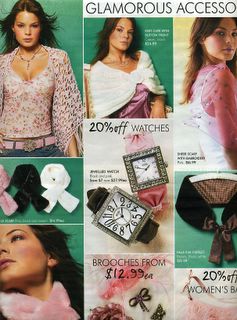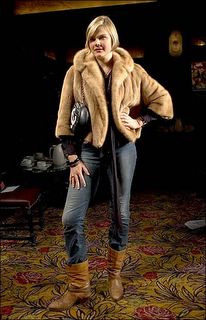Spotted in Dikanyama district, Tokyo, in week of 14-18 February. (Photo: style-arena.jp.)
Look at that scarf. I've never seen anything like it. In another close-up shot, you can see that it's a very chunky knit, embroidered with huge pearls. But from a distance, it looks crisp and prim.
It would be so easy to make. I wonder if you'll see stuff like that here soon, given the knitting craze that gripped Melbourne's young women about two years ago and still continues to get coverage as if it's something wildly novel. Here is an article that's more analytical about the entire DIY fashion phenomenon. It links it to various stages of industrialisation and feminism:
This generation doesn't worry about being mistaken for their mothers because mama didn't knit, sew or bake: She fought the gender wars, leaving these young women free to be glamorous - or whatever they want. [...] Just as the Industrial Age spawned the Arts & Crafts movement, so the Information Age is begetting the Creative movement, in which individuals take charge of their own lives.The article also links the rise of handicrafts to Faith Popcorn's edict that post-9/11, we're all into 'cocooning' - comfort, the domestic sphere, the reassuring rituals and objects of home. It also reminds me of an anti-branding backlash I read about yesterday. Interestingly, staff at Faith Popcorn's consultancy, BrainReserve, are forbidden from wearing branded apparel. Popcorn herself dresses entirely in black Issey Miyake and Armani. I was wondering - if she's so anti-branding, why does she call her dog Miyake? Maybe she equates branded clothing with conspicuous branding, and her clothes are exempt because their branding isn't obvious.
But the idea of customising your clothes to remove any traces of branding seems to me to spring from the same impulse that drives people to make their own scarves. Perhaps these people want something that nobody else has, and their taste is about displaying exclusive aesthetics rather than conspicuous consumption of brands. But there are also brands like Hauser which prominently name themselves (large labels on the outside of the garments), yet are also exclusive (in this case, available at Frauhaus on Brunswick Street). Perhaps the brand is a subcultural item, in its broadest and least Marxist sense.
I wrote about this in 2003 in terms of Australian labels like Gwendolyne, Shem and Alannah Hill. You could also add newer labels like Claude Maus, Willow, One Teaspoon and Camilla + Marc.






